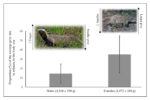Eating like a girl: sex differences in the diet of the lesser grison (Galictis cuja) in southern Brazil
Bruna M. Rodrigues, Felipe B. Peters, Carlos B. KasperThe lesser grison is a hypercarnivore mustelid that is widespread in South America, inhabiting a large variety of habitats, including steppes, deserts, grasslands, forests, and swamps. However, there are few scientific data on the ecology of the species. In our study, we investigate the feeding habits of the Galictis cuja in the Brazilian Pampas by analyzing the stomach contents of road-killed individuals collected from 2013 to 2023. We identify a high consumption of mammals found in 80% of the samples, comprising 75% of the prey consumed. Amphibians, reptiles, and birds are consumed in smaller proportions. Regarding mammals, only rodents were consumed, among which Cavia sp., Holochilus brasiliensis, and Rattus sp. stand out, corresponding to 62% of biomass intake. Although there was no sexual difference in the prey consumed, we found a difference in predation rate, with males consuming more Rattus and females consuming more Cavia. As a result, males are consuming prey that is proportionally smaller (equivalent to 1/6 of their own weight) than that of females (1/3 of their own weight). This is contrary to what is expected due to the sexual dimorphism of the species; in other mustelids, males consume the larger prey.
Comendo como uma menina: diferenças sexuais na dieta do furão (Galictis cuja) no sul do Brasil. O furão-pequeno é um mustelídeo hipercarnívoro amplamente distribuído na América do Sul, ocorrendo em uma variedade de habitats, incluindo estepes, desertos, campos, florestas e áreas úmidas. Todavia, há poucos dados científicos sobre a ecologia da espécie. Nesse estudo investigamos os hábitos alimentares de Galictis cuja na região do Pampa brasileiro, pela análise de conteúdo estomacais de indivíduos encontrados atropelados entre os anos de 2013 e 2023. Identificamos um alto consumo de mamíferos, encontrados em 80% das amostras e compreendendo 75% das presas consumidas. Anfíbios, répteis e aves são consumidos em baixas proporções. No que se refere aos mamíferos, apenas roedores foram encontrados, dentre os quais Cavia sp., Holochilus brasiliensis e Rattus sp. se destacam, correspondendo a 62% da biomassa ingerida. Apesar de não terem sido encontradas diferenças nas presas consumidas por machos e fêmeas, foram encontradas diferenças nos padrões de predação, com machos consumindo mais Rattus e fêmeas consumindo mais Cavia. Como resultado, machos consomem presas proporcionalmente menores (equivalentes a 1/6 de seu peso) do que as fêmeas (com presas equivalentes a 1/3 de seu peso). Isso é contrário ao esperado dado o dimorfismo sexual de tamanho existente nessa espécie e ao observado em outros mustelídeos, em que os machos consomem presas maiores.

